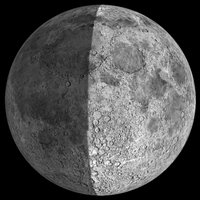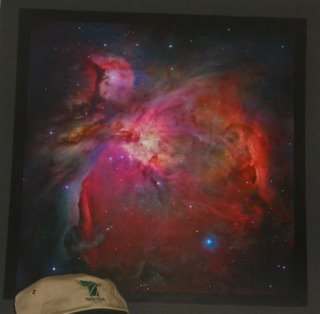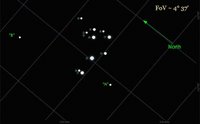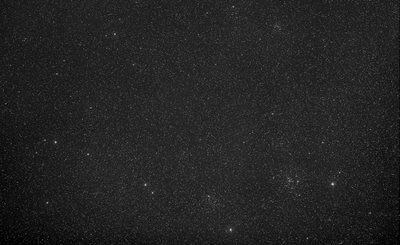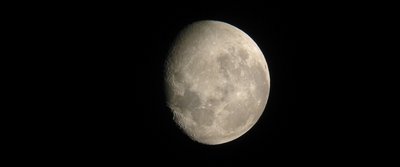Session name: 20061014.2000
Location: Sheep'sMeadow, Central Park, NYC
Moon Age/Illumination: 22.5 days/40.0%
Conditions: Very clear, transparent skies. Windy at times and chilly, dipping into the 40s. New York Gegenschein from CitiCorp & Times Square appeared more pronounced and reached higher up to 70° ~ 80°.
NELM 5.0++
Companions: Kin and Tom C.
Equipment: Harry, 6" F/6 reflector mounted on a Bogen 410 head on a Bogen 3221WN tripod. Shaky mount and the light optical tubing made of foam core catches the wind easily, earning the nickname, "Kite". The wind died down and the scope steadied providing great views of the open clusters.--- * ---
Tonight the Amateur Astronomer's Association (AAA) membership held its annual public outreach event, Urban Starfest. It's a 16 year old event where the Urban Park Rangers partner with the AAA to introduce, raise awareness, and celebrate astronomy under New York City skies. My guess was that there were nearly a dozen scopes, give or take a few more, ranging from tripod-mounted bins to small scopes like a Questar and an Astroscan to larger 8" Schmidt-Cassegrain to the largest scope, a truss tube 12.5" reflector on a Dobsonian mount. There appeared to be a number of 60mm ~ 80mm refractors.
When New Yorkers come together for a common good, like anywhere else, the feeling and inspiration is moving. This session shared that quality. I met up and chatted with a number of the membership including Rich Rosenberg, current President of the AAA and Mike O'Gara, past president of the AAA. And like past years, I got the chance to say hello, chat, and observe with Lynn Darsch. Dan Harrison made some rounds and we spoke of Canadian Rockies and a few of the activities that AAA offers to members and the public. Rik Davis was there whom I see more frequently than others. He is the chair for the Observer's Group meeting and conducts the monthly public observing events and in the park. I missed to see Bruce Kamiat and Alice Barner. These two persons are instrumental in enabling others to pursue an interest in astronomy. I think they attended another AAA event elsewhere in the city.
I also got to meet a number of other people both in and out of the club. In the dark I have a hard time with faces and names needing reinforcement from repeated contact. But one new face, George, will be easy to remember since he is a fellow Teleport telescope owner, #TP10-027. This makes us cousins by way of Tom Noe.
--- * ---
When I arrived it was breezy so I left Harry strapped to the tripod. Seeing that Mike had setup 12.5" reflector, I wanted to see if it was enough to bag M110. This galaxy has escaped detection in NYC skies with repeated tries using the 10" Teleport and once with a Meade 12" reflector. So I *ran* up the 12.5" where Mike invited peeks of M13, the best I've seen in NYC. I asked if he could try for M110. He kindly swung the scope around the sky and offered the view. This galaxy's surface brightness is apparently too low to yield a great enough contrast to see it. By my calcualtions this
thing should be do-able. Unfortunately, it seems like more glass is needed. But how much!?
There was a little chatter that the public may not have been informed of the event. I thought it was a great success with the turnout of scopes and people. I suppose there were more members than general public but I thought it was pretty busy around Harry. But that was exactly what I admired most, seeing the club congregate and celebrate together. I would have liked to look through others' scopes but I got caught up in pushing the scope around and chatting with people that I didn't have much an opportunity.
And with urban astronomy outreach, I think the talk is as important as showing the object. Since the objects lack that spectacularity that is experienced in dark sky views, the description and story are to fill in for any lack of visual fascination. If I taped myself I probably sound like a broken record ~% D Some of these folks have their talk down well, something I could work on.
What follows is a list of objects observed with Harry. With the exception of the Double Double and Uranus, all the objects were observed with low power at 30x in a Tele Vue Plossl 32mm eyepiece. The other two occasions A Tele Vue Nagler 7mm T6 provided a 135x power. Over the course of the session there was a sample from each class of deep sky object - double star, bright nebula, open cluster, globular cluster, galaxy - though open clusters were greatest in quantity. The one object variable star I missed to point out, especially with Algol rising. I'm certain someone else pointed this out.
- Solar System -
Uranus. Under high power we saw the small, bluish disk. Even at low power the planet is a steady solid disk of light contrasted with nearby lambda Aqr.
- Double stars -
gamma Ari. Mesarthim was resolved two equal magnitude white stars. mag 4.6/4.7 sep 7.8". These stars in N-S alignment.
epsilon^1 & epsilon^2 Lyr. The famous "
Double-Double". This was by request from the first person who came by the scope. At 30x both epsilon^1 & epsilon^2 Lyr appear as a wide double, 208" separation. At 135x, both stars resolve as close doubles where there position angles of the pairs are almost perpendicular. epsilon^1 mag 5.4/6.5 sep 2.6", epsilon^2 mag 5.1/5.3 sep 2.3".
- Open Clusters -
in Cassiopeia: M103 (NGC581), NGC225, NGC457 (Owl Cluster), NGC663, Stock 2 (Muscleman Cluster)
in Perseus: M34, NGC869 & -884 (Double Cluster), Melotte 20 (Alpha Persei Association)
in Andromeda: NGC752
in Taurus: M45
NGC 869/884.
Double Cluster. In terms of showing the objects to the public, the Double Cluster has to be the highest on the list for ease of observing and generating a response from non-observers. In contrast to a bleak steel gray sky naked eye, this field is rich! Rich with knots of stars and concentrations of stellar dust. The background sky is mottled from the unresolved starts of the Milky Way. Some find it fascinating when hearing the description of our galaxy and that they are looking into the Outer Arm, a.k.a. the Perseus Arm further out into space.
Stock 2 The Muscleman Cluster is nearby and was placed in the eyepiece for inspection to offer a greater variety of open cluster character and quality. In the 2° field of view this large, loose open cluster rich in stars with a narrow range of magnitude almost fills the entire field. This object also provides an opportunity to describe the different persons involved with cataloging objects in addition to Messier, Herschel & Dryer, and open clusters in particular like Trumpler, King, and Collinder to name a few.
NGC 457,
Owl Cluster/ET Cluster. Second only to the Double Cluster, most persons were impressed by the Owl Cluster. It's fun thinking of a familiar object and decoding this form from the stellar arrangement. First, phi Cas and its secondary are bright enough to draw the eye in and then the fainter stars fall away forming the sine and legs with outstretched arms. It doesn't take much from the imagination to connect the dots to see this shape.
NGC225, NGC581 (M103), NGC663. I showed to some that passed by these open clusters in Cassiopeia. The intent was to show the variety of character these celestial objects can exhibit. Also, each of these objects is a very easy starhop from nearby naked eye stars. NGC225 is just north of gamma Cas while M103 & NGC663 are east, northeast of delta Cas, Ruchbah. NGC225 stood out as a moderately bright, irregular cluster, I would describe as a backward "C", which is bottom-heavy with a concentration of stars. In comparison with NGC225's size, about 15 arc minutes, NGC663 appears equally as large but with a more bright, hazy patches to each side of the central bright stars. In the hazy patches, stars twinkle into resolution and are lost again into the haze. A pretty sight that mimics the behavior of "virtual particles". M103 is nearby and actually first seen when hopping from Ruchbah. I find it as an unimpressive cluster and is not easy to describe to the public. In fact a tiny knot of three stars appears further east that some are confused by. Similarly, Trumpler1 is in this area nearby but would be difficult to point out and lacks that "spectacularity" that other objects can emote from the observer.
M34. Another easy, bright open cluster in Perseus but on the other side of Mirfak. M34 is easy to find since it is large and bright. I usually hop off of kappa Per and move ~5 west or one can look at a spot halfway between Algol and Almach (gamma And). On first glance I am struck with the impression of two concentric rings of brighter stars and the middle contains a loose concentration fainter stars.
- Bright Nebula -
M57 The Ring Nebula. The only bright nebula observed. Since I was nearby with the Double Double I swung the scope on this nebula, later by request I picked this object again. At 30x, this object was very faint against the background sky, obvious to a trained observer but not the best object for the public since it is hard to pick up and some may need to use averted vision without experience. Sheliak, beta Lyr, is a bright double star with a fainter secondary that I typically hop of from on my way to M57.
- Globular Cluster -
M13. This was the first object I observed and fine tuned the alignment of the paper towel tube that serves as the finder. The woman who asked to see the Double Double was the only who observed this globular in this scope. In contrast to the view in the larger scope, this view exhibited an even, pale glow across the entire object.
- Galaxies -
M31 & M32. Andromeda Galaxy was another popular object, probably the most requested. Andromeda Galaxy is bright enough to be seen in any size instrument. It takes a larger instrument and steady view to pullout M32. In the 6", it was fairly easy to see the small right triangle to the south of the M31 where the farthest star is blurred and doesn't resolve. Much can be told to the public about Andromeda, especially as a specimen which to describe the likenesses it exhibits.
One can describe the evolution of man's understanding of our galaxy referencing men like Kapetyn, Shapley, and Hubble. It wasn't until the 1920's that Shapley began to describe our galaxy in its truer size and our location within it.
Andromeda Galaxy is a classical spiral galaxy to fascinate new observers and the public. We can see the bright nucleus and core as a fuzzy "cotton ball" in the eyepiece. We register this light that left the swarming cluster of Population II stars in that galaxy 2.2 million years ago With a diamter of about 150,000 light years, Andromeda Galaxy is larger than the Milky Way, and the largest galaxy of our local group. In 3 billion years or so, Andromeda and Milky Way will collide and most likely combine. Both galaxies have already acquired smaller ones.


